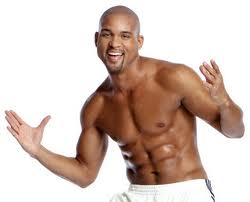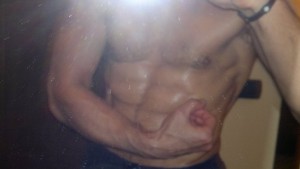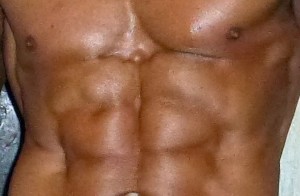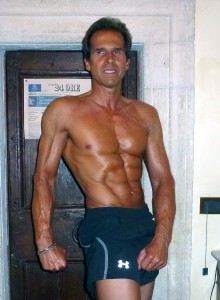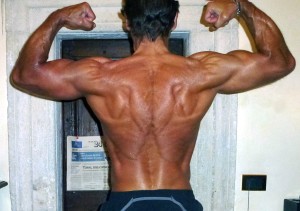Title: How To Lose 20 Pounds Really, Really Fast!
By line: By Tom Venuto, CSCS, NSCA-CPT
Word count: 1816 words
How To Lose 20 Pounds Really, Really Fast By Tom Venuto, NSCA-CPT, CSCS www.BurnTheFat.com!
Back “in the day” when I was a full time personal trainer and I met with weight loss clients in person at my New Jersey Health Club, the first thing I would always ask during the initial consultation was:
“Tell me what you want… and I’ll show you how to get it.”
Typical reply from client:
“I want to lose 20 pounds fast.”
My reply:
“Are you SURE that’s what you want? …If I can show you how to lose 20 pounds REALLY fast, will that make you happy?”
They nodded their head affirmatively as their eyes lit up in anticipation of the rapid weight loss secrets I was about to reveal…
Their face went white when – with a totally straight face – I pulled out a hacksaw and started walking towards them…. menacingly.
Not sure whether to laugh or run in sheer terror, they said,
“What the heck are you doing?”
“You said you wanted to lose 20 pounds fast. This is the easiest, surest, most effective way I know to take 20 pounds off you FAST! In fact, I figure that right leg of yours might even weigh 25 pounds!”
I kept walking closer and started to get into sawing position, wielding my fast, effective and guaranteed weight loss tool…
“Bear with me because this IS quick, but sometimes it takes a few minutes for me to cut through the bone.”
By this time, my client (and I) are either completely cracking up, I have seriously scared the living you know what out of them, or they just think I’m a complete lunatic… (depends on whether I was able to keep a straight face or not)
Finally, the light bulb goes on, and my client would see where I was going with this:
“Okay, smart alec,” I get it… I don’t want to lose WEIGHT, I want to lose FAT.”
Sometimes I would be having so much fun, I would just keep on playin’…
“But why not? This is easy, fast and guaranteed – just what everyone wants these days… it’s even better than taking a pill! Come on… let me hack it off! You’ll be my next testimonial: ‘I lost 20 pounds in 5 minutes!’ Imagine what that will do for my business!”
“Very funny. I told you, I get it! I want to lose FAT, not muscles and bones. I need my leg!”
Naturally, of course, I don’t always have to pull out my trusty blade. Every once in a while… about as often as a total solar eclipse… a client answers my question like this:
“What do I want? Tom, I want to lose 20 pounds of body fat in the next 12 weeks. I want to do it slowly, safely and healthfully and then keep it off permanently. I want all the fat around my hips and thighs completely gone and I want a firm flat stomach. I want muscle all over my body while still looking feminine. I’d like to see myself at about 16% body fat and maintain all my muscle or gain a few pounds of lean mass if I can, especially in my arms. This is important to me because I want to set a good example for my kids, I want to be healthy and live to at least 90 and I want my husband to look at me and say, “I love your body,” and I want to be able to *honestly* say back to him, “me too!”
It is on these rare occasions that I know there is still intelligent life on this planet.
If you could answer the question, “What do you want” with the lucidity, clarity and specificity that this woman did, I don’t think you would ever have any difficulty reaching your health and fitness goals… or any other goal in your life, for that matter.
Her answer was what you call a very “well-formed” goal, backed up with lots of emotional motivation-inducing “reasons why.”
“I want to lose weight” is a poorly-formed goal.
“Weight” is not the same as “fat.” Weight includes muscle, bone, internal organs as well as lots and lots of water.
If you only learn ONE thing from all my newsletters, articles and books, PLEASE learn this:
WHAT YOU REALLY WANT IS TO BURN THE FAT, WHILE KEEPING THE MUSCLE!!!!
FAT LOSS is what you want, not weight loss.
If your body were 100% rock-solid muscle, with absolutely nothing that jiggled (unless it was supposed to), would you care how much you weighed?
I bet you wouldn’t! And if that’s true, then…
STOP WORSHIPPING THE SCALE AND START MEASURING YOUR BODY COMPOSITION!
By measuring your body fat, you take the guesswork out of your health and fitness plan and you get an accurate picture of what’s really happening in your body as a result of your diet and exercise program.
Instead of worrying about whether you are losing muscle, or wondering if you are losing fat, you can measure it and KNOW for sure. (I always get a good chuckle when someone tells me they’re worried about losing muscle when they don’t even measure how much muscle they have!)
Instead of being confused by all the “opinions” from weight loss and exercise “experts” who are all telling you something different, you can MEASURE your body composition and based on the results, you can KNOW for sure whether your program is working.
A very wise man once said,
“A single measurement is worth a thousand opinions.”
So, how do you measure body fat?
Thanks to technology, there are some methods today that are so accurate, they can tell you whether your left pinky has more fat than your right pinky! Unfortunately, many of them are either too expensive or they are inaccessible, being found only in hospitals or research facilities
If you want to learn a LOT about various body fat testing methods, chapter 3 of my e-book, Burn The Fat, Feed The Muscle (www.BurnTheFat.com!) goes into great detail about the pros and cons of all the various fat testing methods. Instead of re-hashing it all here, let me give you three quick and easy, practical suggestions:
Suggestion 1: Have a trainer or fitness professional measure you if this service is available at your local health club. Sometimes, there’s a charge – usually $15 – $25, although some clubs offer the service for free to all their members.
Suggestion 2: Purchase an Accu-measure skinfold caliper. Do a google or yahoo search to find a reseller.
The Accu-measure was designed to allow you to measure your own body fat in the privacy of your own home (you don’t need someone else to measure you)
Some people wonder if this is really accurate. Truth is, it’s not quite as accurate as a multi site skinfold test from an experienced tester, but what’s most important is not the “accuracy” per se, but the reliability and consistency of your measurements so you can track your progress. Skinfold calipers in general are not accurate or inaccurate, it’s the person doing the test that is accurate or inaccurate.
Suggestion 3: If you have a spouse, roommate, or friend who can measure your body fat, you can purchase a Slim Guide body fat caliper (or just about any brand of caliper) from Creative Health Products: chponline.com
The Slimguide is the best inexpensive caliper available (about $20), but it wasn’t designed for you to measure your own body fat like the Accu Measure. You’ll need someone to measure you with this caliper. Other models of body fat calipers (if you want to splurge), range from $150 to $450. (At our health clubs, I use the electronic “SKYNDEX” caliper with the 4-site “Durnin formula.”)
The calipers come with instructions, or you can use these formulas, which I have used and found to be very accurate:
4 Site formula for men (abdomen, suprailiac, thigh, tricep)
% fat = .29288(sum of 4 skinfolds) – 0.0005(sum of four skinfolds squared) + 0.15845(age) – 5.76377
4-Site Formula for women (abdomen, suprailiac, thigh, tricep)
% Fat = (.29669)(sum of 4 skinfolds) – (.00043)(Sum of four skinfolds squared) + .02963(age) + 1.4072
[Source: Jackson A S, Pollock, M (1985) Practical assessment of body composition. Physician Sport Med. 13: 76-90.]
Body fat percentages vary based on age and gender, but 20-25% body fat is average for women (15-19% is ideal), while 15-20% is average for men (10-14% is ideal). I have detailed charts for body fat charts in my e-book if you’re interested.
Once you know your body fat percentage, then weigh yourself and record your weight and body fat on a progress chart such as the one found in my Burn The Fat Feed The Muscle Program (a fat loss program, not a weight loss program). This chart is how you will track your progress and “keep score.”
You can calculate your lean body mass (muscle and other fat free tissue) very easily just by crunching some numbers:
For example, if you weigh 200 pounds and you have 10% body fat then you have 20 pounds of fat (10% of 200 = 20). That means you have a lean body mass (LBM) of 180 pounds.
Now we’re talking! With this data, you can get a really clear picture of how your exercise and nutrition program are affecting your physique.
Losing weight is very easy. Losing fat – and keeping it off without losing muscle – is a much bigger challenge. If you simply wanted to lose weight, we could just chop off your leg.
Or, (slightly less painful), I could show you how to drop 10 – 15 pounds over the weekend just by dehydrating yourself and using natural herbal diuretics. Wrestlers do it all the time to make a weight class. But what good would that do if it’s almost all water and you’re just going to gain it all back within days?
You don’t have to “throw away your scale” like many “experts” tell you to. By all means, keep using the scale, the tape measure and even photographs and the mirror – the more feedback the better – but body fat is where it’s at.
By the way, I recently bought a chain saw and a shiny new axe from Home Depot, and I’ve been practicing my “American Psycho” and Jack Nicholson, “The Shining” impersonations… so if you want to come to my office any time soon for personal consultation, you’d better have the right answer to my question, “What do you want?”
For more information about a nutrition and training program that focuses exclusively on FAT LOSS, not WEIGHT LOSS, visit: www.BurnTheFat.com!
About the Author:
Tom Venuto is a lifetime natural bodybuilder, an NSCA-certified personal trainer  (CPT), certified strength & conditioning specialist (CSCS), and author of the #1 best-selling e-book, “Burn the Fat, Feed The Muscle.” Tom has written hundreds of articles and been featured in IRONMAN, Australian IRONMAN, Natural Bodybuilding, Muscular Development, Exercise for Men and Men’s Exercise, as well as on dozens of websites worldwide. For information on Tom’s Fat Loss program, visit: www.BurnTheFat.com!
(CPT), certified strength & conditioning specialist (CSCS), and author of the #1 best-selling e-book, “Burn the Fat, Feed The Muscle.” Tom has written hundreds of articles and been featured in IRONMAN, Australian IRONMAN, Natural Bodybuilding, Muscular Development, Exercise for Men and Men’s Exercise, as well as on dozens of websites worldwide. For information on Tom’s Fat Loss program, visit: www.BurnTheFat.com!
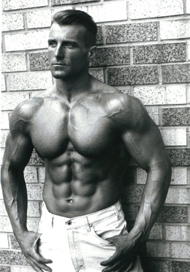 Burning Secrets of the World’s Best Bodybuilders and Fitness Models. Tom is a lifetime natural bodybuilder and fat loss expert who achieved an astonishing 3.7% body fat level without drugs or supplements. Discover how to increase your metabolism and burn stubborn body fat, find out which foods burn fat and which foods turn to fat, plus get a free fat loss report and mini course by visiting Tom’s site at: www.BurnTheFat.com!
Burning Secrets of the World’s Best Bodybuilders and Fitness Models. Tom is a lifetime natural bodybuilder and fat loss expert who achieved an astonishing 3.7% body fat level without drugs or supplements. Discover how to increase your metabolism and burn stubborn body fat, find out which foods burn fat and which foods turn to fat, plus get a free fat loss report and mini course by visiting Tom’s site at: www.BurnTheFat.com!




